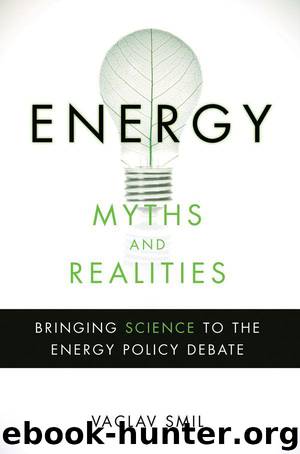Energy Myths and Realities: Bringing Science to the Energy Policy Debate by Smil Vaclav

Author:Smil, Vaclav [Smil, Vaclav]
Language: eng
Format: mobi, azw3
ISBN: 9780844743288
Publisher: AEI Press
Published: 2010-08-15T16:00:00+00:00
Ethanol has been portrayed in highly positive terms: as the world’s best choice for cutting dependence on crude oil and lowering the carbon intensity of the global economy;3 as a perfect green energy solution (“Sugar beet, corn, wheat. Our recipe for renewable fuel,” claims an advertisement from BP, the British global energy company); as an income stabilizer for grain farmers; as a fuel source that could get much better (“How much ethanol can a company extract from corn? . . . There’s no telling how much mileage our efforts may yield down the road,” boasts leading chemical company BASF, as though photosynthetic efficiency were infinitely elastic).
Europe, where nearly half of all passenger cars have diesel engines, is more smitten by biodiesel. This fuel can be extracted from a wide variety of oil-bearing crops, including such common temperate plants as rapeseed, sunflowers, and soybeans. In the tropics, it is oil palm and jatropha that many enthusiasts see as the means of liberating poor countries from their dependence on imported oil needed to fuel trucks, irrigation pumps, and small electricity generators. Such visions ignore the fact that the oil palm plantations have been a major cause of tropical deforestation, and that we know little about jatropha’s domestication and long-term agronomic requirements, ignorance of which has already led to the abandonment of unrealistic plans for mass-scale jatropha cultivation.4 Biofuel enthusiasts envision making use even of waste fats, among other suggestions for unusual—even bizarre—biofuel sources. These include kelp in California’s waters and kudzu vines covering abandoned land in the U.S. Southeast, the harvesting of either of which would be no small challenge, and poppy seeds from Afghanistan—one need only look at the size of those seeds and check the yield of oil per unit of cultivated area to see how viable that proposal is! My assessment of liquid biofuel’s prospects will concentrate first on the ethanol made from corn (by fermentation of carbohydrates that make up about 75 percent of the harvested grain) or sugar cane (by fermentation of sucrose expressed from cane stalks) that is to substitute for automotive gasoline.
Download
Energy Myths and Realities: Bringing Science to the Energy Policy Debate by Smil Vaclav.azw3
This site does not store any files on its server. We only index and link to content provided by other sites. Please contact the content providers to delete copyright contents if any and email us, we'll remove relevant links or contents immediately.
The Secret History by Donna Tartt(18945)
The Social Justice Warrior Handbook by Lisa De Pasquale(12165)
Thirteen Reasons Why by Jay Asher(8841)
This Is How You Lose Her by Junot Diaz(6833)
Weapons of Math Destruction by Cathy O'Neil(6214)
Zero to One by Peter Thiel(5730)
Beartown by Fredrik Backman(5673)
The Myth of the Strong Leader by Archie Brown(5456)
The Fire Next Time by James Baldwin(5380)
How Democracies Die by Steven Levitsky & Daniel Ziblatt(5170)
Promise Me, Dad by Joe Biden(5112)
Stone's Rules by Roger Stone(5051)
A Higher Loyalty: Truth, Lies, and Leadership by James Comey(4905)
100 Deadly Skills by Clint Emerson(4879)
Rise and Kill First by Ronen Bergman(4739)
Secrecy World by Jake Bernstein(4698)
The David Icke Guide to the Global Conspiracy (and how to end it) by David Icke(4655)
The Farm by Tom Rob Smith(4465)
The Doomsday Machine by Daniel Ellsberg(4449)
